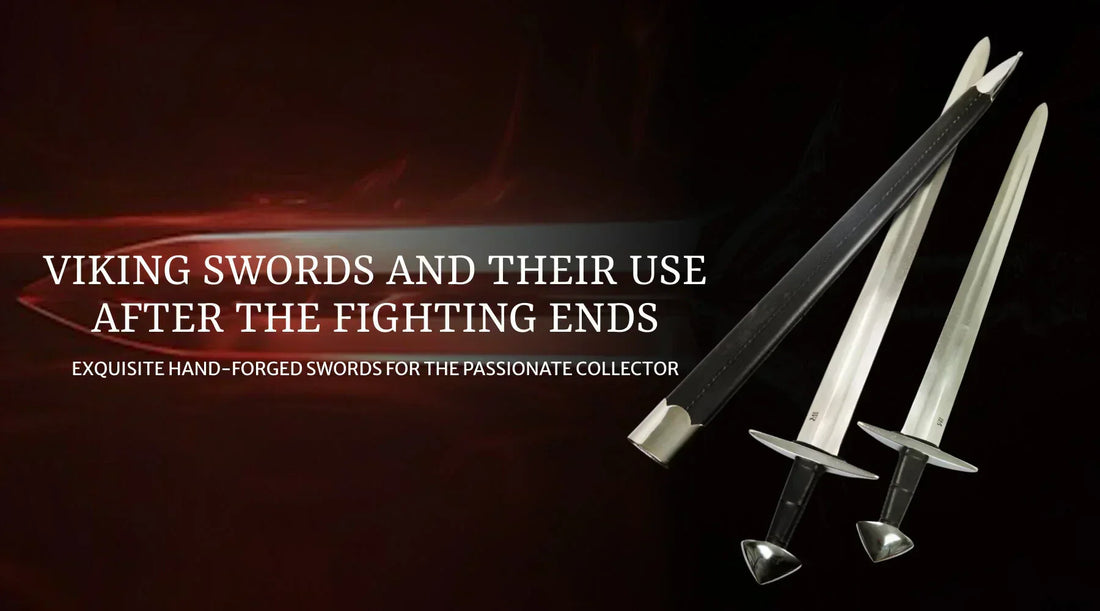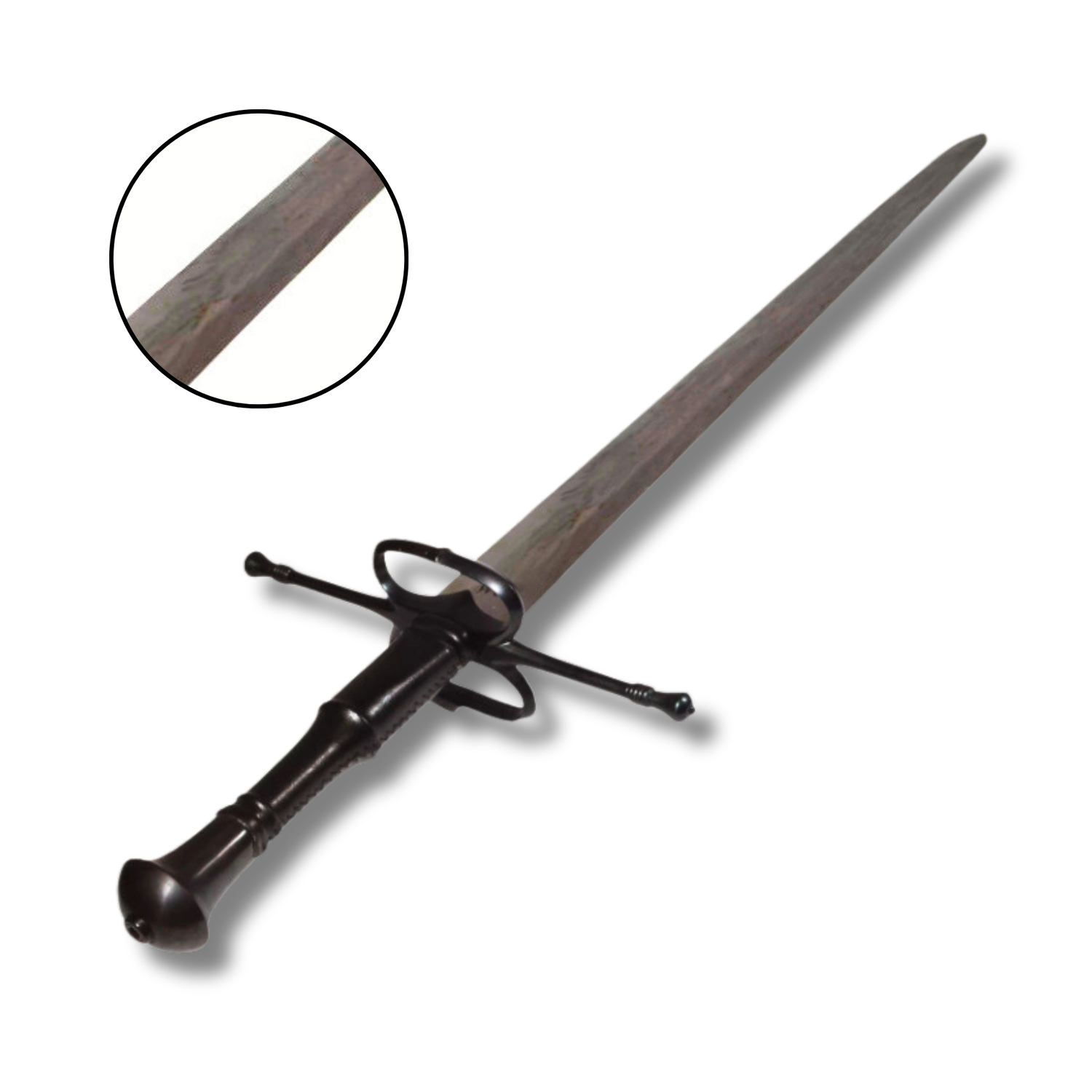
Viking Swords and Their Use After the Fighting Ends
The Viking Age, spanning roughly from 793 to 1066 AD, was a period marked by legendary warriors, epic voyages, and powerful weapons. Among these weapons, Viking swords hold a place of honor not only for their craftsmanship but for the cultural and symbolic value they carried.
But what happened to these swords when the battles were over? Were they simply sheathed and stored away? Or did they continue to play a role in the lives of Viking warriors?
In this blog, we will explore the fascinating history of Viking swords, the origins of their iconic names, and their use after combat. Whether you're a history buff or looking to shop Viking swords, this guide will offer deep insights into their purpose, legacy, and value today.
What Are Viking Swords?
Viking swords were the primary weapons of elite Norse warriors. Typically double-edged and ranging between 28 and 36 inches in length, these swords were finely crafted from pattern-welded iron or steel. They were far more than mere killing tools, they were status symbols, heirlooms, and sacred possessions.
Unlike axes or spears, which were common among farmers and foot soldiers, swords were expensive to produce. This made them the weapons of noblemen, chieftains, and accomplished fighters. Owning a sword was a sign of prestige and power, a treasure often passed down through generations.
A Brief History and Evolution
Early Viking swords were inspired by the Roman spatha, a long, straight sword used by Roman cavalry. Over time, Norse blacksmiths developed their versions, characterized by heavier blades and sturdier hilts. These swords often featured ornate crossguards and pommels, sometimes inlaid with silver, copper, or bronze.
One of the most significant innovations in Viking sword-making was the use of "pattern welding," a technique where several iron and steel rods were twisted and forged together to produce a blade that was both strong and flexible.
The Ulfbehrt swords, some of the most legendary examples, even contained high-carbon crucible steel, far ahead of their time in Europe. The inscription "+ULFBERH+T" marked swords of superior quality and craftsmanship.
Origins of Viking Sword Names
Did Vikings name their swords? Absolutely. Much like ships or animals, swords were given personal names that reflected their power, myth, or history. These names weren’t just for fun, they were believed to give the weapon a soul.
Names like “Leg-Biter” or “Blood Serpent” were common. Swords that earned fame in battle were remembered in skaldic poems and sagas. Owning a sword with a known name was akin to possessing a piece of divine heritage.
Some Viking swords today have been named after historical figures, archaeological finds, or modern replicas, such as the Osprey Viking Sword, Godfred Viking Sword, or Ulfberht Viking Sword, each representing a unique style or era.
Did Vikings Use Swords?
Did Vikings use swords as their primary weapon? The answer is yes, but with a caveat. Not all Vikings had the means to afford a sword. Most relied on spears or axes, which were easier to make. However, seasoned warriors, nobles, and kings often carried swords both on and off the battlefield.
A sword was more than a military asset. It was a personal companion, often worn proudly during peace gatherings, rituals, and feasts, the more decorated the sword, the greater the respect its owner commanded.
In battle, Viking swords were typically used for slashing due to their wide blades and balance. Thrusting wasn’t common in Norse combat techniques. Their sharp edges could easily cut through armor or bone with a well-placed blow.
Viking Swords After Battle: Still Honored
So what happened after the fighting ended?
Contrary to what you might think, Viking swords were not just stashed away. They remained a visible and active part of Viking life:
1. Status Symbol in Peace Time
Wearing a sword after battle symbolized victory and honor. At assemblies or “Things” (Norse political gatherings), a sword was a silent declaration of one’s prowess and rank.
It wasn’t uncommon for retired warriors to carry ceremonial swords as part of their attire, signaling their legacy without needing to speak a word.
2. Sacrificial and Ritual Use
Viking culture was deeply spiritual. Many swords were used in religious ceremonies or offered as sacrifices to the gods. Archaeologists have uncovered swords that were deliberately bent or broken before being placed in rivers or burial mounds, symbolizing the weapon’s journey to the afterlife.
Some swords were buried with their owners, because a Viking wouldn’t want to face Valhalla without his blade.
3. Inheritance and Legacy
A Viking sword was a family treasure. Passed from father to son, these blades carried stories of raids, duels, and victories. They were often engraved or marked to show their lineage.
Swords like the Ulfberht Viking Sword became legendary and highly sought after, prized for their unmatched quality.
Famous Viking Swords: Legacy in Modern Times
Today, names like Godfred Viking Sword or Osprey Viking Sword resonate through history and the replica market. Authentic historical finds often inspire these modern interpretations.
-
The Godfred Viking Sword pays homage to King Godfred of Denmark, who stood against Charlemagne’s empire.
-
The Osprey Viking Sword is designed with elegance and balance, ideal for collectors and reenactors.
-
And, of course, the Ulfberht Viking Sword remains the most iconic, its mysterious inscription is still debated by historians.
Where to Shop Viking Swords Today
Whether you're a collector, reenactor, or just a fan of Norse culture, there’s no better way to honor Viking heritage than by owning a replica sword. When you shop Viking swords, always look for authenticity, craftsmanship, and historical accuracy.
Brands like Warrior Replicas specialize in producing museum-quality replicas of Viking artifacts that accurately mirror their original designs. Their blades aren’t just decorative, they’re forged to tell a story, to keep history alive in your hands.
You can find functional swords for reenactments, ceremonial swords for display, or even lightweight versions for cosplay. Just remember, owning a Viking sword isn’t about violence, it’s about legacy.
Warrior Replicas offers an excellent selection of the Godfred Viking Sword and Osprey Viking Sword, both crafted with attention to detail and built to reflect the power of their historical roots.
A Sword Beyond the Battlefield
Viking swords were never just about battle. They were symbols of honor, tools of heritage, and bridges between worlds. From fierce combat to sacred rituals, these weapons played roles that extended far beyond blood and steel.
So the next time you admire a blade or consider adding one to your collection, remember, a Viking sword was never just forged for war. It was forged for memory, glory, and eternity.
If you're ready to bring a piece of this legendary history home, shop Viking swords through reputable sources like Warrior Replicas and let the spirit of the Norse live on through your hands.
